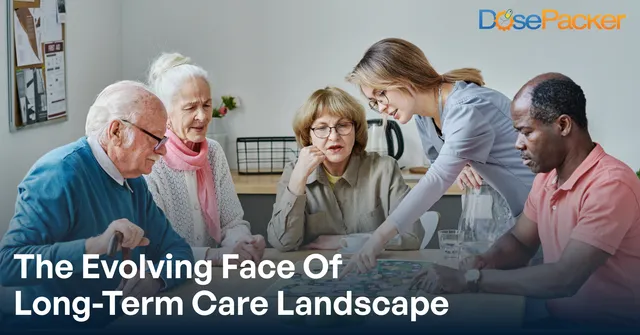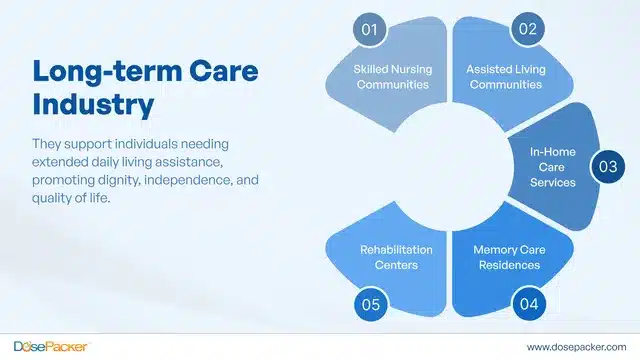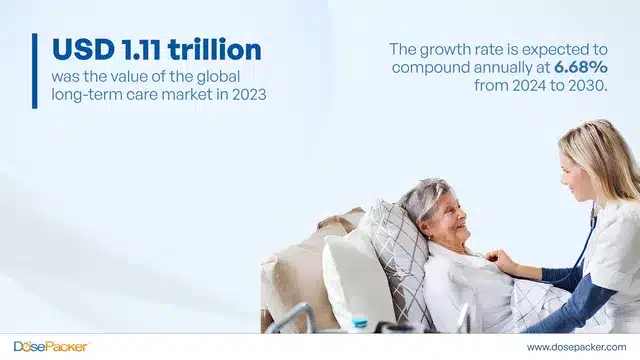Unlock the latest in medication management technology and grow your care community with us.

Long-term care is a crucial component of healthcare services, providing ongoing support for individuals who need assistance with daily activities due to health issues, disabilities, or aging-related concerns.
Within healthcare, long-term care offers services to help individuals maintain their well-being and independence. These include:
- Assistance with Activities of Daily Living (ADLs)
- Medication Management
- Home Health Services
- Residential Care
- Care Coordination
Finding the ideal partner, like DosePacker, with innovative solutions and a commitment to improving health outcomes is essential. DosePacker ensures your long-term care community gets the attention and precision medication management it deserves.
Enhance Long-Term Care with DosePacker
Who Needs Long-Term Care?
Long-term care is needed by various groups of people who require ongoing assistance with daily activities. These include:
1: Seniors
Physical or cognitive decline often prevents people from performing tasks such as bathing, dressing, or managing medications independently. Globally, an estimated 142 million seniors are experiencing difficulty meeting their basic needs independently.
2: Individuals with Disabilities
People with physical or intellectual disabilities may require long-term care to help with daily living activities and support their overall well-being.
3: Patients Recovering from Serious Injuries or Surgeries
After experiencing a severe injury or undergoing major surgery, patients may require extended assistance with rehabilitation, recovery, and managing their medication.
4: Individuals with Chronic Illnesses
Chronic conditions such as diabetes, heart disease, or cancer may require ongoing management and support, including assistance with medication management and monitoring of health status.
5: Individuals with Cognitive Impairments
Conditions like Alzheimer’s disease and other forms of dementia often necessitate specialized care and support to help individuals maintain their safety and quality of life.
Demographic factors also play a role in determining who needs long-term care. Considering these ensures that long-term care services are equitable, culturally sensitive, and responsive to the population’s diverse needs. Here are some key demographic characteristics to consider:
1: Age Distribution
Long-term care recipients span a wide range of ages, but the majority are older adults. About 70% of people worldwide who turn 65 years old will require long-term care.
2: Gender
Both men and women may need long-term care, but there are gender-based variations. Women who tend to live longer may require long-term care services for an extended period. Over 70% of long-term care community residents are women. Additionally, women 75 or older are more likely to need help with daily living activities.
3: Ethnicity and Race
Some ethnic and racial groups, like Hispanics, have higher rates of chronic conditions, often needing long-term care. Factors such as genetics and geographic location contribute to this. A Media Market study showed that about 94.4% of Hispanic patients use long-term care services.
A proficient long-term care pharmacy with innovative solutions is essential to ensuring equitable and efficient service. Tools like DosePacker’s CommunityCareOS are indispensable, as they streamline communication and care coordination for optimal care delivery between the care community and the pharmacy.
Long-Term Care Industry Overview 2024

Fortunately, the long-term care industry encompasses a diverse array of services and settings aimed at providing care and support to individuals with chronic illnesses, disabilities, or aging-related needs.
The World Health Organization (WHO) has emphasized the importance of establishing equitable and sustainable long-term care systems in every country to address the diverse needs of individuals. This commitment aligns with Sustainable Development Goal 3, which ensures healthy lives and promotes well-being for all ages.
Nowadays, long-term care services can be provided in various settings, including:
1: Skilled Nursing Communities
These communities provide round-the-clock medical care and assistance with daily activities for individuals who require a higher level of support due to complex medical needs or functional limitations.
2: Assisted Living Communities
Offer a more independent living environment while still helping with activities of daily living, such as medication management, meals, and housekeeping.
3: In-Home Care Services
Provide personalized in-home support, including personal care, meals, medication reminders, and household tasks. The MyDoses App allows caregivers and patients to easily manage medication schedules on their mobile devices.
4: Memory Care Residences
These residences offer a secure and structured environment tailored to the needs of individuals with cognitive impairments, including Alzheimer’s disease and other forms of dementia.
5: Rehabilitation Centers
Rehabilitation centers provide intensive therapy and rehabilitation services for individuals recovering from injuries, surgeries, or acute medical events such as strokes.
With various settings and services, like DosePacker’s innovative solutions, individuals can receive care and support tailored to their preferences and circumstances.
Long-Term Care Global Market Overview

According to a report published by Grand View Research, the global long-term care market reached a valuation of USD 1.11 trillion as of 2023 and is anticipated to exhibit a robust compound annual growth rate (CAGR) of 6.68% from 2024 to 2030.
Recent data from the United States highlights the significant use of long-term care services:
- According to the Centers for Medicare & Medicaid Services, approximately 1.2 million people reside in skilled nursing communities in July 2022.
- Over 800,000 individuals in the U.S. reside in assisted living communities.
- There are about 502,640 Home Care Providers in the U.S. as of 2023.
- As of 2021, there are more than 30,000 memory care residences around the United States.
- Physical Therapy Rehabilitation alone amounts to 50,516 centers in the U.S.
Rising demand for services is influenced by long-term care trends, such as:
Aging Population
The WHO reports that the global population aged 80 and older is expected to triple between 2020 and 2050. People become more prone to needing long-term care services for age-related health conditions and functional limitations as they age.
Rise in Chronic Diseases
Rising rates of chronic diseases like diabetes, heart disease, and Alzheimer’s are driving increased demand for long-term care. Long-term care is essential for managing these conditions and maintaining individuals’ quality of life.
Shift in Healthcare Delivery
A growing emphasis is on shifting healthcare delivery from acute care settings to community-based and home-based care models. This trend drives the demand for in-home care services and alternative long-term care options.
The long-term care market will continue to expand due to increasing demand driven by demographic shifts, rising chronic diseases, and evolving healthcare delivery models, as seen in long-term care industry trends.
DosePacker: Your Trusted Partner in Long-Term Care
DosePacker recognizes the critical role of streamlined medication processes in improving outcomes and enhancing the quality of care for all.
Our innovative solutions, like CareCommunityOS and compliance packaging, empower residents with medication adherence issues and optimize workflows in long-term care facilities. DosePacker’s commitment to patient safety is reflected in DoseKart, providing efficient storage and medication transportation in healthcare environments.
As a trusted partner in the long-term care industry, DosePacker commits to supporting healthcare communities, caregivers, and offers pharmacies to provide the highest standard of care to individuals from all walks of life.
Experience the Best Care DosePacker Has to Offer
Long-term care is essential for the well-being and quality of life of those with chronic illnesses, disabilities, and age-related limitations. As our population ages and healthcare advances, accessible, high-quality care becomes increasingly critical. By understanding unique needs and embracing innovation, we can create a future where everyone receives the care and support they deserve.
Let’s ensure a future where long-term care is effective, compassionate, and empowering for all.
































